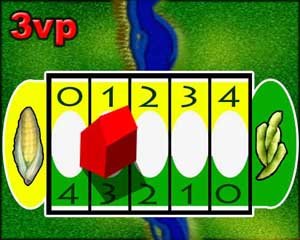Since BGDF has moved over to a new server, they will eventually lose all of their old posting. So now I have to keep a record of my showdown entries somewhere else. Well, at least the ones I find to be viable...Love Me Blender!(manufactured by Presley Kitchenware Inc.)Two players create love potions to move Pat on the Infatuation Line.Components:-The Love Me Blender[1] and Blender Base[2].
-Marbles, in four "Ingredient" colors, and additionally, black and clear.
-Marble bag.
-8 small bowls.
-Board showing the Infatuation Line[3] and many potion recipes[4].
-Pat, a pawn.
-Markers to cover up used recipes.
Setup:-Place Pat on the Zero space on the Infatuation Line.
-Black and colored marbles go in the bag, clear marbles in a bowl off to the side.
-Each player gets a bowl for their stock of Ingredients. Four "Storehouse" bowls are placed in the center of the table. The last bowl is used for black marbles.
-Decide who goes first.
Gameplay:A player performs one of the following two choices:
-Collect Ingredients:The player takes all the marbles from one Storehouse and places them into his personal stock.
-or-
-Attempt A Potion:The player takes any amount of marbles from his stock and places them into the Blender along with an equal amount of clear marbles[5]. The Blender is then shaken by the player; the opposing player may also shake it if he feels that it is not mixed enough. Place Blender on the Blender Base and Press "MIX", which releases all marbles into the reservoirs.
All clear marbles are returned to their bowl.
Remaining marbles in the BAD reservoir are returned to the bag.
Remaining marbles in the RETURN FROM BLENDER reservoir are divided up and placed into the four Storehouse bowls in any way the acting player decides.
The player selects ONE unmarked potion from the board by matching the ingredient list of the potion to the marbles in the GOOD reservoir[6]. The player puts a marker on this potion[7] and moves Pat the number of spaces indicated on the potion, or to the next colored space that is indicated by the potion[8] towards himself.
If there are no potions available that match the GOOD marbles, the player fails to make a potion and cannot move Pat.
All GOOD marbles are returned to the bag.
After doing either A or B above, the player then pulls 5 random marbles from the bag. Black marbles go in the 5th bowl. The player then distributes the colored marbles anyway he wishes in the 4 Storehouses.
The other player takes his turn.
A round ends immediately when A)Pat hits a 10 point space for one player, or B) 6 black marbles are in the 5th bowl.
Pat scores points for the player based on which side he is on. The points awarded are listed on the space Pat is on. Return Pat to the zero space. Return all black marbles and marbles from players personal stocks to the bag. A new round starts[9].
Points are doubled for the 2nd round, tripled for the third. The game is over after 3 rounds, or if all potions have been covered. Best total score wins.
[1] The Blender is a plastic toy that looks like a typical Blender which holds many marbles, except that the pitcher is opaque. There is a "MIX" button on the front. Inside, there are three holes which marbles can escape from down into the Blender Base when it is placed on the Base. These holes are normally blocked (marbles cannot escape) by a spring-locked sliding trap door mechanism. Pressing the "MIX" button slides the trap open, releasing all of the marbles through the three holes.
[2] The Blender sits on the Blender Base, which has three reservoirs for catching marbles (these are labeled "GOOD", "BAD", "RETURN FROM BLENDER"). Inside the Blender, funnel shapes lead into the holes which roughly distributes the marbles so that 1/2 go to the "GOOD" reservoir, 1/4 go to "BAD", and 1/4 go to "RETURN FROM BLENDER".
[3] The Infatuation Line looks like this:

[4] There are two types of Potions: "move X Spaces" and "Move to Color."
Examples:
"Empathy Elixier. 2 red/1 yellow. move 1 space."
"Howl at the Moon. 1 red/1 yellow/1 green/2 blue. move 2 spaces."
"Sweet Clementyne. 4 blue/3 red/1 yellow. move to Purple."
"Chocolate High. 4 green/2 yellow/2 blue. move to Yellow."
[5] Clear marbles are added to prevent suspicious shaking in the hopes of getting more marbles to fall into the "GOOD" reservoir.
[6] Odds are, many GOOD marbles will be unused when matching to a potion.
[7] Any potion is only used once during the entire game. Pat becomes immune quickly.
[8] There is no 10 space colored potion; a potion that "moves X spaces" would be required to move there.
[9] Markers from potions are not removed when a new round starts. More complex potions will be used during later rounds. Likewise, storehouses are not "reset."
Labels: BGDF, GDS, Love Me Blender




